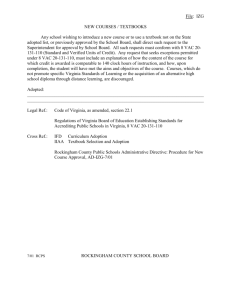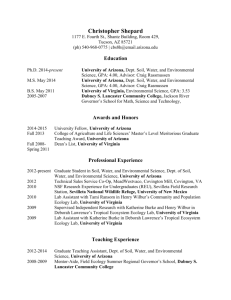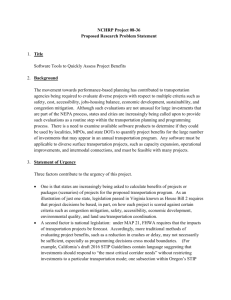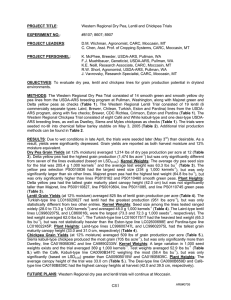Appalachian Farming Systems Research Center
advertisement
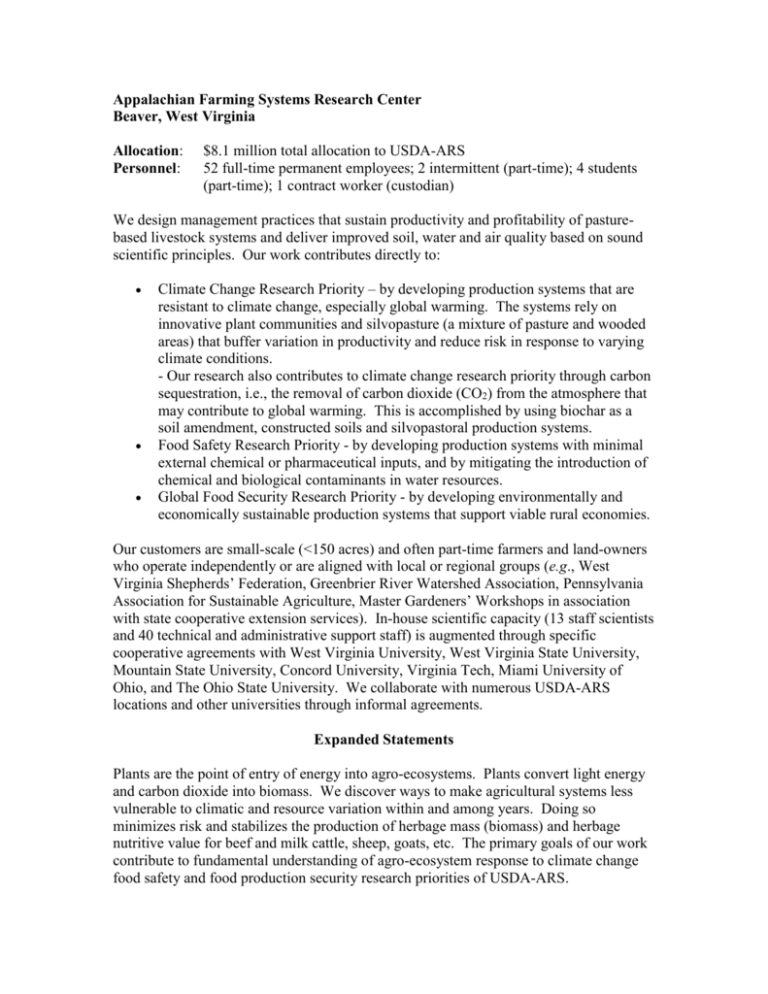
Appalachian Farming Systems Research Center Beaver, West Virginia Allocation: Personnel: $8.1 million total allocation to USDA-ARS 52 full-time permanent employees; 2 intermittent (part-time); 4 students (part-time); 1 contract worker (custodian) We design management practices that sustain productivity and profitability of pasturebased livestock systems and deliver improved soil, water and air quality based on sound scientific principles. Our work contributes directly to: Climate Change Research Priority – by developing production systems that are resistant to climate change, especially global warming. The systems rely on innovative plant communities and silvopasture (a mixture of pasture and wooded areas) that buffer variation in productivity and reduce risk in response to varying climate conditions. - Our research also contributes to climate change research priority through carbon sequestration, i.e., the removal of carbon dioxide (CO2) from the atmosphere that may contribute to global warming. This is accomplished by using biochar as a soil amendment, constructed soils and silvopastoral production systems. Food Safety Research Priority - by developing production systems with minimal external chemical or pharmaceutical inputs, and by mitigating the introduction of chemical and biological contaminants in water resources. Global Food Security Research Priority - by developing environmentally and economically sustainable production systems that support viable rural economies. Our customers are small-scale (<150 acres) and often part-time farmers and land-owners who operate independently or are aligned with local or regional groups (e.g., West Virginia Shepherds’ Federation, Greenbrier River Watershed Association, Pennsylvania Association for Sustainable Agriculture, Master Gardeners’ Workshops in association with state cooperative extension services). In-house scientific capacity (13 staff scientists and 40 technical and administrative support staff) is augmented through specific cooperative agreements with West Virginia University, West Virginia State University, Mountain State University, Concord University, Virginia Tech, Miami University of Ohio, and The Ohio State University. We collaborate with numerous USDA-ARS locations and other universities through informal agreements. Expanded Statements Plants are the point of entry of energy into agro-ecosystems. Plants convert light energy and carbon dioxide into biomass. We discover ways to make agricultural systems less vulnerable to climatic and resource variation within and among years. Doing so minimizes risk and stabilizes the production of herbage mass (biomass) and herbage nutritive value for beef and milk cattle, sheep, goats, etc. The primary goals of our work contribute to fundamental understanding of agro-ecosystem response to climate change food safety and food production security research priorities of USDA-ARS. AFSRC, Beaver, W. Va. Summary - continued Climate Change We develop systems that improve small-acreage farm productivity and sustainability within the Appalachian region. We do this by reducing risk through multi-cropping sequences and plant communities (e.g., silvopastoral practices that provide wood-biofuel, forage for sheep, goats, beef cattle, and understory crops). Technology is applicable to hill-land environments world-wide with resource and climatic features similar to those of central Appalachia. These production systems are resilient to climatic variability. We design grazing systems for small-acreage farms that accommodate the soil, plant and animal resources capable of adapting to within and among year weather patterns. We develop the practical technology to apply biochar produced from charring of poultry litter or plant residues from the biofuels industry to improve the production capability of soil and increase carbon sequestration. This work is being done in collaboration with other USDA-ARS laboratories (Eastern Regional Research Center, Wyndmoor, Pa.; Southern Regional Research Center, New Orleans, La.). Improvements include chemical and physical attributes of soil including sequestering chemical and biological contaminants of ground water and improving plant productivity through hospitable rooting environments. We also determine how management systems influence nutrient cycling and reduce atmospheric CO2 (carbon sequestration to help mitigate possible global warming). Food Safety - local production, nutritional composition, external inputs We discover bioactive pasture plants materials that can help maintain sheep and goat health. Decreasing the need to administer pharmaceutical products can help reduce production costs and minimize the quantity of drugs administered to grazing animals. These practices will provide safer meat products for consumers and reduce pharmaceutical residues entering soil and water resources. Management practices are designed to meet livestock nutritional needs while preventing chemical and biological contamination of water resources. Global Food Security We develop management strategies for cattle, sheep and goat production on terrain not suitable for cultivated row crops to help diversify food production and directly support local food production systems. Locally produced livestock can contribute significantly to food availability and can provide additional sources of meat products for the growing US and world populations. Also, local sources provide alternative resources of meat should concentrated livestock production systems in the U.S. become compromised. Our work with West Virginia University, Clemson University and Virginia Tech shows that pasture-based livestock meat composition can provide health conscious consumers with a lower fat and cholesterol product compared to conventionally produced beef.





